If Asia's economic engine is slowing down, someone forgot to tell B.C. exporters.
The province's exports to its main Asian trading partners were up 5.8% last year compared with 2012, reaching $13.7 billion, and the pace continued through 2014's first six months, up another 5% compared with the same period a year ago.
Even though mainland China's gross domestic product growth slowed to 7.7% last year, compared with 10.4% at its peak in 2010, that country remains the biggest Asian buyer of B.C. products, consuming $6.6 billion of the province's goods in 2013 – primarily coal and pulp. (The U.S. remains by far the biggest destination for B.C. goods, accounting for 46% of B.C. exports last year, compared with 20% for China.)
But the pace of growth in B.C.'s exports to China is slowing, and that will have an impact on B.C., according to Ken Peacock, chief economist at the Business Council of BC. With monthly growth hovering around plus or minus 2% compared with the previous year, exports to China are essentially flat, Peacock said.
“When you go from 10%, 15%, 20% year-over-year growth to essentially flat, that is a little bit of a different world.”
But Peacock added that those export numbers are a reflection more of price than of volume; B.C.'s resource companies will continue producing coal and lumber, so the jobs will still be there, but the impact will show up in earnings reports.
“It does mean lower corporate profits, which has an impact on British Columbia,” Peacock said, “and in some segments it might mean less production, which means a little bit of scaling back in job opportunities or hours worked.”
Despite a population rivalling China's, similar economic growth and a burgeoning middle class, India remains a relatively insignificant destination for B.C. goods. It accounted for just $468 million in exports last year – primarily coal and copper ore.
India's appetite for B.C.'s raw materials isn't likely to rival China's in the foreseeable future, according to Peacock, because unlike China, which has been investing in a manufacturing-oriented export economy for decades, India's economy is geared more toward technology and services.
However, Peacock added, when services, particularly tourism, are included in B.C. exports, India shows potential for growth.
“I know with China tourism is going to be big, but we'll probably have some opportunity with tourism in India as well.”
Education, he said, is also a growing export to both countries. Economists consider tourism and education to be exports because they represent an injection of money into the local economy from external sources. B.C. will likely continue to depend on natural resources for the bulk of its Asian exports for the foreseeable future; however, Peacock points to growth opportunities in one value-added sector.
“Probably the biggest opportunity in Asia generally, but particularly in China, would be the agricultural sector,” he said.
That's because as the middle class continues to grow, there will be an increasing demand for meat and fish products in particular, but also more generally for higher-quality food.





